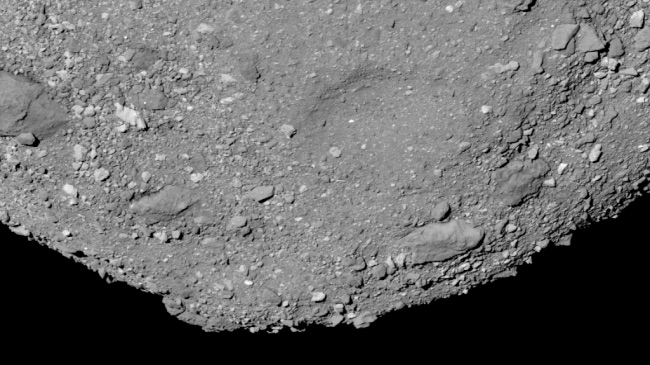Asteroid Bennu Goes Technicolor in 3-D NASA View

You've never seen an asteroid like this before.
This technicolor marvel is a compilation of more than 11 million measurements of an asteroid called Bennu, all gathered by a NASA probe called OSIRIS-REx. That spacecraft arrived in December and since then has been conducting a carefully planned survey of the space rock.
Related: How OSIRIS-REx's Team Creates Amazing Asteroid Bennu Photos
The 3-dimensional view is based on data gathered in February and shows the surface height of Bennu, with a nearly 200-foot (60-meter) difference in height between the lowland dark blue areas and the red peaks.
Now, the spacecraft has just entered a phase called the Detailed Survey: Equatorial Stations, and follows the Detailed Survey: Baseball Diamond stage that the team behind the mission just concluded. Both stages are detailed examinations of the asteroid, which the spacecraft will sample as the culmination of its mission at Bennu.

The Baseball Diamond phase — named for a previous design of the precise path of the spacecraft around the asteroid, although the trajectory was redesigned in a way that eliminated that similarity — lasted nearly two months and resulted in some incredible images of Bennu's rocky surface.
The largest of those rocks is particularly striking in this image, taken from about 3 miles (4.8 kilometers) away. In it, the boulder takes up much of the 191-foot-wide (58 meters) field of view. The image was captured by the spacecraft's PolyCam camera on March 7.
Sign up for the Live Science daily newsletter now
Get the world’s most fascinating discoveries delivered straight to your inbox.

A later maneuver during the Baseball Diamond phase resulted in wider-angle images of the asteroid, like one showing off Bennu's south pole. This image shows much more of the asteroid itself — the field of view spans 847 feet (258 m). In addition to the asteroid's rocky surface, this view also shows a large crater dimpling Bennu.
Now that it has transitioned into the Equatorial Stations stage of its survey, OSIRIS-REx will take on a different pattern for scanning Bennu's surface. The phase will last through June, at which point the spacecraft will slip into a steady orbit about 0.6 miles (1 km) above the asteroid.

And that maneuver will break the spacecraft's own record for the closest to a small celestial body that a probe has ever orbited. By the time this phase ends in the fall of 2019, the team will have selected the candidate sites for sample collection.
But OSIRIS-REx has plenty of time to continue to scope out Bennu's rocky surface and tease out its secrets — the spacecraft isn't due to head back to Earth until March 2021.
- Hello, Bennu! NASA Asteroid-Sampling Probe Reaches Its Target Space Rock
- As the Asteroid Turns: NASA Probe Snaps Video of Spinning Bennu
- Zoom! Asteroid Bennu Slips Past in OSIRIS-REx Flyby View
Email Meghan Bartels at mbartels@space.com or follow her @meghanbartels. Follow us on Twitter @Spacedotcom and on Facebook.
p.p1 {margin: 0.0px 0.0px 12.0px 0.0px; font: 12.0px Arial; color: #000000; -webkit-text-stroke: #000000} p.p2 {margin: 0.0px 0.0px 12.0px 0.0px; font: 12.0px Arial; color: #255a7e; -webkit-text-stroke: #255a7e} p.p3 {margin: 0.0px 0.0px 24.0px 0.0px; font: 12.0px Arial; color: #000000; -webkit-text-stroke: #000000} p.p6 {margin: 0.0px 0.0px 0.0px 0.0px; font: 12.0px Arial; color: #000000; -webkit-text-stroke: #000000} li.li4 {margin: 0.0px 0.0px 0.0px 0.0px; font: 11.5px Arial; color: #255a7e; -webkit-text-stroke: #255a7e} li.li5 {margin: 0.0px 0.0px 24.0px 0.0px; font: 11.5px Arial; color: #255a7e; -webkit-text-stroke: #255a7e} span.s1 {font-kerning: none} span.s2 {text-decoration: underline ; font-kerning: none; color: #255a7e; -webkit-text-stroke: 0px #255a7e} span.s3 {font-kerning: none; color: #000000; -webkit-text-stroke: 0px #000000} span.s4 {color: #000000; -webkit-text-stroke: 0px #000000} span.s5 {font: 11.5px Arial; text-decoration: underline ; font-kerning: none; color: #255a7e; -webkit-text-stroke: 0px #255a7e} span.s6 {font-kerning: none; color: #255a7e; -webkit-text-stroke: 0px #255a7e} ul.ul1 {list-style-type: disc}
Meghan is a senior writer at Space.com and has more than five years' experience as a science journalist based in New York City. She joined Space.com in July 2018, with previous writing published in outlets including Newsweek and Audubon. Meghan earned an MA in science journalism from New York University and a BA in classics from Georgetown University, and in her free time she enjoys reading and visiting museums. Follow her on Twitter at @meghanbartels.











